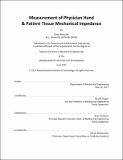| dc.contributor.advisor | Neville Hogan and Brian Anthony. | en_US |
| dc.contributor.author | Mercado, David (David Eduardo) | en_US |
| dc.contributor.other | Massachusetts Institute of Technology. Department of Mechanical Engineering. | en_US |
| dc.date.accessioned | 2017-10-04T15:04:52Z | |
| dc.date.available | 2017-10-04T15:04:52Z | |
| dc.date.copyright | 2017 | en_US |
| dc.date.issued | 2017 | en_US |
| dc.identifier.uri | http://hdl.handle.net/1721.1/111709 | |
| dc.description | Thesis: S.M., Massachusetts Institute of Technology, Department of Mechanical Engineering, 2017. | en_US |
| dc.description | Cataloged from PDF version of thesis. | en_US |
| dc.description | Includes bibliographical references (pages 195-198). | en_US |
| dc.description.abstract | This study investigates various methods by which a previously developed hand-operated actuated device is capable of measuring the mechanical impedance of both the compliant patient tissue in contact with its end effector and of the hand of the operator holding the device. The particular device being investigated is an actuated ultrasound probe originally designed to regulate the amount of force exerted by a sonographer to their patient during an ultrasound scan. We expect that quantifying the effective mechanical impedance of the operator hand will lead to improvements in the design and control of hand-operated devices. Improvements are being considered not only to improve the quality and reliability of the ultrasound scan, but to alleviate the chronic muscular and joint stress endured by sonographers over the course of their careers. An additional motivation behind this study is to augment the capabilities of physicians to diagnose medical conditions, such as breast cancer and liver cirrhosis, on the basis of tissue impedance without the need for an additional mechanism. Several methods were developed for approximating mechanical impedance using the actuated ultrasound probe, based on the sensors available and models of the device dynamics. Due to sensor limitations, impedance measurement could only be effectively implemented for a single interface, instead of both concurrently. These methods involved immobilizing one end of the device. Experiments were conducted on artificial tissues in order to confirm that the methods developed were valid and reliable for measuring mechanical impedance of the body in contact with either the sonographer or patient end of the device. | en_US |
| dc.description.statementofresponsibility | by David Mercado. | en_US |
| dc.format.extent | 198 pages | en_US |
| dc.language.iso | eng | en_US |
| dc.publisher | Massachusetts Institute of Technology | en_US |
| dc.rights | MIT theses are protected by copyright. They may be viewed, downloaded, or printed from this source but further reproduction or distribution in any format is prohibited without written permission. | en_US |
| dc.rights.uri | http://dspace.mit.edu/handle/1721.1/7582 | en_US |
| dc.subject | Mechanical Engineering. | en_US |
| dc.title | Measurement of physician hand & patient tissue mechanical impedance | en_US |
| dc.title.alternative | Measurement of physician hand and patient tissue mechanical impedance | en_US |
| dc.type | Thesis | en_US |
| dc.description.degree | S.M. | en_US |
| dc.contributor.department | Massachusetts Institute of Technology. Department of Mechanical Engineering | |
| dc.identifier.oclc | 1003859384 | en_US |
